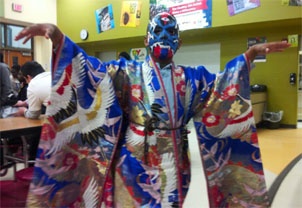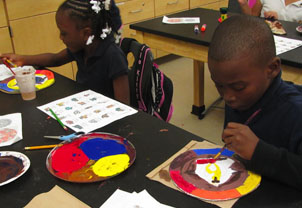Program Profile: Peoria Public School District 150
If you visit the Peoria Public Schools District 150’s 21st CCLC program, you are likely to see students meeting with a local artist or choreographing a Chinese dragon dance to perform at an upcoming showcase. These are just a few of the activities students participate in as part of the 21st CCLC’s arts integration programming.
 | |
| A fourth-grade student at Glen Oak Community Learning Center performs a kabuki theater routine. |
Operating at two sites, Glen Oak and Harrison primary schools, the program has approximately 95-100 students enrolled and an average daily attendance of 60 students at each location. Students explore the four arts disciplines-dance, drama, music, and visual arts-which also serve as a vehicle for academic enrichment. Lessons are carefully planned and designed to incorporate the Common Core State Standards, Illinois Learning Standards, and National Fine Arts Standards.
Sharon Reed, the project outreach liaison, is quick to point out that the arts are the focus of the program, and not just an elective. “We believe that the arts integration model of transforming teaching and learning in and through the arts will help close the achievement gap,” she says. “The 21st CCLC grant has provided our teachers and students with an exciting, innovative program. . . . Learning through the arts reaches students on every level.”
The program has close ties to the community and the schools at which the two sites are located. Students work with community studio artists and have visited many of Peoria’s museums and the city’s planetarium. “It has been amazing to see students become excited about the arts and museums," says Crystal Radavanovic, site coordinator from the Peoria Riverfront Museum. “Many of our students have never stepped . . . inside a museum. They are learning what a wonderful resource they are, as well as how they work and how to behave in a museum setting.”
 | |
| Third-grade students at Harrison Community Learning Center paint Aztec calendar color wheels. |
To help align activities with school curriculum, each site has a certified lead teacher who serves as a liaison between the school day and the afterschool program. This person maintains constant communication with the project outreach liaison and the site coordinator, about student needs. She also works with school and district staff and shares district and state assessment with the afterschool team so that they can discuss it and use it to design units of study. Shanica Davis, the lead teacher at Glen Oaks, sees the program as a way to help students of all learning styles both explore the arts and master academic content. “Students have ongoing opportunities to improve their core academic skills, while also being engaged in developing skills and concepts relating to the arts,” she says.
For afterschool leaders who want to offer more arts integration activities, Reed encourages them to advocate with both passion and research. “Arts programming must be articulated as essential to the overall curriculum,” she says. “We as educators must begin to think of the arts as part of the core curriculum instead of ‘enrichment activities.’ The arts are much, much more!”
